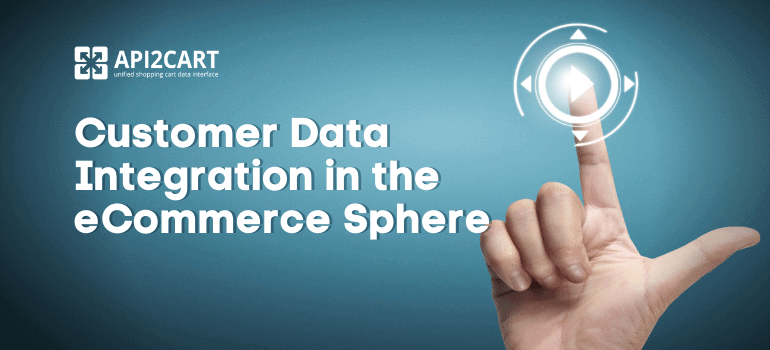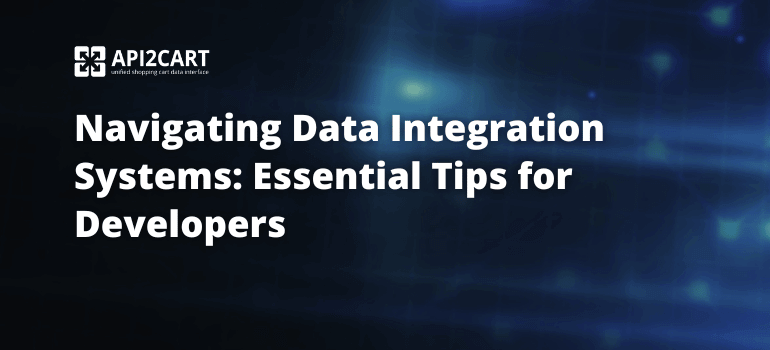
Like every other business, eCommerce stores depend on effective customer data management to capitalize on their sales and marketing efforts.
Customer data is available on the eCommerce platforms where the merchants have built their e-stores. Access to such data is also the key to a successful B2B software that help e-merchants to be more successful using their customers’ info. Also, it allows such solutions to enhance the value of their software and provide their clients with a one-stop solution for all their eCommerce operations.
Here’s where customer data integration fits into the big picture. In case you provide software that depends on the access to e-store customer details, you need to connect it with eCommerce platforms like Magento, Shopify, WooCommerce, etc. It allows you to retrieve customer data from these platforms and facilitate efficient eCommerce operations.
What is Customer Data Integration in eCommerce?
As the name suggests, customer data integration is the process of collecting and organizing data from different datasets or databases so that it can be accessed in a more usable form. The organization of data in a single place makes it easily retrievable and analyzable for deducing patterns and decision making.
In the era of eCommerce, customer data integration is just the same - collection of customer-related data from various eCommerce platforms like Amazon, eBay, Shopify, Magento, etc., and organization in a single place (an eCommerce software in this case).
Data related to customers of a client’s online store can only be gathered from their eCommerce platforms. Integration establishes a connection between the software and the platforms, which allows the former to access the data from shopping platforms. The process is termed API integration, wherein the APIs of both the applications integrate to facilitate the data transfer.
Why do eCommerce Software Need Online Store Customer Data?
eCommerce software like marketing automation systems, cart abandonment software, chatbots, etc., depend highly on customer data to perform their core functionality. Therefore, all these software need data related to customers to use it to provide their designated functions to the e-merchants. To do this, eCommerce software needs to integrate with the source of such data, that is, the eCommerce platforms.
For instance, marketing automation systems need customer data so they can perform the following functions:
- Send emails as updates on new items on the store, discounts, and offers on certain products, and product recommendations.
- Notify the customers about their order statuses like shipping date, dispatch date, and delivery date.
- Track the customer’s order history to know about their frequently purchased products and plan marketing emails accordingly.
All the functions mentioned above are the core functions of a marketing automation software which cannot be performed effectively if the software doesn’t have access to customer data from the client stores. Without customer data integration with eCommerce platforms, it is not possible to extract such data from the client stores and organize it for performing all the functions.
Self-service software like chatbots also depend on customer data so they can help the customers with their orders via online chat.
What Kind of Customer Data is it Possible to Get from eCommerce Platforms?
As mentioned above, there are various eCommerce software that depend on customer data to perform their core operations. Specifically, such data includes details like:
- customer id
- customer email
- customer first name and last name
- customer birthday
- customer gender
- customer phone
- customer address
- customer wishlist
- customer order history, etc.
For example, marketing automation systems use information like customer name, email, birthday, gender, wishlist, and order history to send their personalized marketing emails. These emails generally include recommended products based on their wishlist or order history, discounts or offers on their favorite products, or products left in the cart.
Similarly, cart abandonment systems use customer name, email, and products left in the cart to send emails and encourage the customers to complete their purchases.
Multichannel systems use collected customer data to organize in a single dashboard for the merchants to know their customers, their buying behaviors, order history, and analyze their relationship with the business. These systems also prepare reports which the marketing analysts can study to draw trends and patterns and utilize for their future decisions.
How to Retrieve Customer Data from eCommerce platforms?
You need to integrate your eCommerce software with shopping platforms to retrieve customer data. However, integrations are painful and bring a lot of challenges associated with them. It takes a lot of time, money, and resources to set up the infrastructure, hire advanced developers, establish integrations, and then maintain them.
With API2Cart, customer data integration is a seamless process as it is a unified API that allows your eCommerce software to connect with more than 40 eCommerce platforms at once. It doesn’t keep you waiting with individual integrations, costly setup, and infrastructure and maintenance.
Moreover, it has more than 100 methods to retrieve data from eCommerce platforms like Amazon, eBay, Shopify, Magento, WooCommerce, etc. All you need to do is integrate your software with API2Cart, and in turn, it will integrate it to all the eCommerce platforms on which your clients have their e-stores.
For accessing customer data, API2Cart has the following API methods:
- customer.list - This method allows the software to retrieve a list of customers from the client stores.
- customer.info - This method allows the software to get customers’ information from the client store.
To know more about how API2Cart works, book a free consultation call with us.



